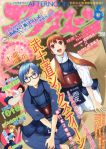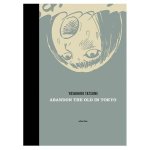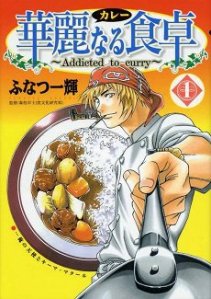Welcome to the first installment of The Seinen Alphabet! As you can see, I’m going to take a slightly different (and marginally less lazy) approach this time around, with snippets about magazines and individual titles (licensed and still yet-to-be translated) primarily targeted at adult men and creators who’ve worked in the category. As you’ll hopefully see, seinen seems like one of the more fluid demographic categories, sometimes seeming more aimed at people who just plain like good comics. But don’t worry! I’ll try not to skimp on the boobs and violence that seem so at home in some seinen quarters. Without further ado…
“A” is for…
 AFTERNOON, a monthly manga anthology published by Kodansha. Many excellent comics been serialized in this magazine, some of which have been published in English, and some of which are high on the list of titles I’d like to see licensed. (In the former category is Yuki Urushibara’s Mushishi, which is the topic of the current installment of the Manga Moveable Feast.) Here’s the link to the magazine’s website.
AFTERNOON, a monthly manga anthology published by Kodansha. Many excellent comics been serialized in this magazine, some of which have been published in English, and some of which are high on the list of titles I’d like to see licensed. (In the former category is Yuki Urushibara’s Mushishi, which is the topic of the current installment of the Manga Moveable Feast.) Here’s the link to the magazine’s website.
One of those is by Hitoshi ASHINANO, and it’s called Yokohama Kaidashi Kikō. I’ve written about that book here.
Staying on the subject of unlicensed seinen, devotees of culinary manga yearn for an English-language version of ADDICTED TO CURRY, written and illustrated by Kazuki Funatsu and serialized in Shueisha’s Weekly Young Jump. Over 30 collected volumes of the tale of a struggling restaurant are in print.
 One of the most well-known seinen titles is probably Katsuhiro Otomo’s AKIRA, which has been available in English for many years and is being re-released by Kodansha USA. Many people cite AKIRA as their gateway manga, and it’s been adapted into a highly regarded animated film. The manga originally ran in Kodansha’s Young Magazine.
One of the most well-known seinen titles is probably Katsuhiro Otomo’s AKIRA, which has been available in English for many years and is being re-released by Kodansha USA. Many people cite AKIRA as their gateway manga, and it’s been adapted into a highly regarded animated film. The manga originally ran in Kodansha’s Young Magazine.
 CMX has released the four volumes of ASTRAL PROJECT, written by marginal (also known as Garon Tsuchiya of Old Boy fame) and illustrated by Syuji Takeya. It’s a meditative piece of science fiction, sprinkled liberally with social commentary, and it’s excellent and odd. It originally ran in Enterbrain’s Comic Beam, a rich vein of clean-burning seinen ore.
CMX has released the four volumes of ASTRAL PROJECT, written by marginal (also known as Garon Tsuchiya of Old Boy fame) and illustrated by Syuji Takeya. It’s a meditative piece of science fiction, sprinkled liberally with social commentary, and it’s excellent and odd. It originally ran in Enterbrain’s Comic Beam, a rich vein of clean-burning seinen ore.
 One should always take the opportunity to mention the godfathers when such opportunities present themselves, so I’ll note that Viz published Osamu Tezuka’s ADOLF, a five-volume thriller about three men with that unfortunate name, including the one who made it so infamous. ADOLF originally ran in Bungeishunjû’s Shukan Bunshun. I’ll also note that another seinen work by Tezuka, AYAKO, is due for publication in October 2010 by Vertical.
One should always take the opportunity to mention the godfathers when such opportunities present themselves, so I’ll note that Viz published Osamu Tezuka’s ADOLF, a five-volume thriller about three men with that unfortunate name, including the one who made it so infamous. ADOLF originally ran in Bungeishunjû’s Shukan Bunshun. I’ll also note that another seinen work by Tezuka, AYAKO, is due for publication in October 2010 by Vertical.
 Both of these either fall into or were inspired by the seinen subcategory known as gekiga, offering realistic drama based on real-world concerns and complex interpersonal relationships. While Tezuka can be credited with a lot of the building blocks of what we consider modern manga, we must cede ownership of the gekiga movement to Yoshihiro Tatsumi. Some of Tatsumi’s startling and bleak gekiga stories have been collected by Drawn & Quarterly as ABANDON THE OLD IN TOKYO.
Both of these either fall into or were inspired by the seinen subcategory known as gekiga, offering realistic drama based on real-world concerns and complex interpersonal relationships. While Tezuka can be credited with a lot of the building blocks of what we consider modern manga, we must cede ownership of the gekiga movement to Yoshihiro Tatsumi. Some of Tatsumi’s startling and bleak gekiga stories have been collected by Drawn & Quarterly as ABANDON THE OLD IN TOKYO.
One of the most interesting things about seinen is that it seems like such an equal-opportunity category to me. Many of my favorite works have been written and illustrated by women. Perhaps this is because many seinen magazines are less for the vague demographic of “adult men” and more for “people who still like comics after adolescence is over.” I could be wrong, but it seems like more women and girls read seinen and shônen than men and boys read josei and shôjo, so perhaps it isn’t surprising that a respectable number of women create seinen and shônen.
 One of those women is Kumiko Suekane, creator of AFTERSCHOOL CHARISMA, which originally ran in Shogakukan’s IKKI and is now being serialized online by Viz prior to print publication. It’s about a high school for clones of famous and infamous historical figures. If you’ve ever yearned to read of the teen adventures of bishie versions of Napoleon, Freud, and Hitler, this is the comic for you. I didn’t even know that I’d yearned to read such a thing until Viz made it possible.
One of those women is Kumiko Suekane, creator of AFTERSCHOOL CHARISMA, which originally ran in Shogakukan’s IKKI and is now being serialized online by Viz prior to print publication. It’s about a high school for clones of famous and infamous historical figures. If you’ve ever yearned to read of the teen adventures of bishie versions of Napoleon, Freud, and Hitler, this is the comic for you. I didn’t even know that I’d yearned to read such a thing until Viz made it possible.
Another is Moyoco ANNO. She’s worked in shôjo (Sugar Sugar Rune) and josei (Happy Mania), but I believe one of her biggest hits runs in a seinen magazine, Kodansha’s Morning. It’s called Hataraki Man, and I want very badly for someone to license it. She’s also done a one-volume series called Sakuran for Kodansha’s Evening.
So, what starts with the letter “A” in your seinen alphabet?
Updated: I can’t believe I forgot another great creator, Hideo AZUMA, who has worked in a variety of categories during his career. He also created a wonderful autobiography, Disappearance Diary, which was published in English by Fanfare/Ponent Mon. One of his seinen titles, Yakekuso Tenshi, was serialized by AKITA SHOTEN in its Play Comic anthology.
 Updated again: In the comments and on Twitter, the redoubtable Ed Chavez, who has probably forgotten more about seinen than I’ll ever know, unravels Wikipedia’s web of lies and assures me that Denkeki Daioh, a MediaWorks magazine, falls in the seinen demographic. I thought it did, but all of the references I could find indicated that it was shônen, so I blinked. (Maybe it’s just targeted at developmentally arrested adult males. It would hardly be the first entertainment to do so.) Anyway, this allows me to celebrate not only the brilliantly funny KIYOHIKO AZUMA, but also his AZUMANGA DAIOH (Yen Press), simply the funniest four-panel manga ever to be made available in English. (I’ll get to Yotsuba&! later, presuming the four million magazines that start with the word “Young” don’t push me over the edge as I work on the “Y” entry.)
Updated again: In the comments and on Twitter, the redoubtable Ed Chavez, who has probably forgotten more about seinen than I’ll ever know, unravels Wikipedia’s web of lies and assures me that Denkeki Daioh, a MediaWorks magazine, falls in the seinen demographic. I thought it did, but all of the references I could find indicated that it was shônen, so I blinked. (Maybe it’s just targeted at developmentally arrested adult males. It would hardly be the first entertainment to do so.) Anyway, this allows me to celebrate not only the brilliantly funny KIYOHIKO AZUMA, but also his AZUMANGA DAIOH (Yen Press), simply the funniest four-panel manga ever to be made available in English. (I’ll get to Yotsuba&! later, presuming the four million magazines that start with the word “Young” don’t push me over the edge as I work on the “Y” entry.)
And JTabon reminds me of INIO ASANO, that gifted portrayer of disaffected youth. Viz has published Asano’s single-volume solanin and two-volume What a Wonderful World! solanin originally ran in Shogakukan’s Young Sunday, and What a Wonderful World! ran in Shogakukan’s Sunday GX. Asano was recently profiled in The Daily Yomiuri and credited with “stories of youth that would be too alien or embarrassing for full-fledged adults.” As a full-fledged adult, I have to take issue with that, though I do tend to view them with a little bit of what I can only describe as old-man smugness.

I can’t think of any As, other than Addicted to Curry which I have been requesting for years. Won’t somebody take pity on me and release it here
I really home Azuma’s follow up (“Depression Diary” I think) is published soon. DD was so good.
Wow! I love the new look of your alphabet feature! I look foward to reading about more seinen titles that have yet to be licensed, the mangaka who write them, and the magazines that publish them.
Just the thought of Emma and Astral Project being serialized in Comic Beam together makes my head spin. Manga mags have some awesome variety!
Ahhh don’t go here Mr Welsh…Dig too deep into the seinen well and you might stir up some manga demons.
AI-Ren: Before there was moe the concept of nurturing your own bishojo robot was taken to new heights in this touching manga from (Hakusensha/Jets Comics)
Asumi: Outside of a handful of magazines, most with a soft-core bend, gekiga is dead. But if one contemporary manga is it’s true successor it is possibly Asumi. Combining old-school character designs, amazing research on Japanese political and religious history, and manga’s most accessible ninja Asumi does what Lone Wolf & Cub’s Itto Ogami only dreamed he https://precur.wordpress.com/2010/04/28/the-seinen-alphabet-a/could do to the public conscious and sales records. Asumi continues to be in my top 7 all time and I publicly curse Viz for not giving this series a chance. (Shogakukan/Big Comics Superior)
Akagi: Mahjong manga done right…totally grotesque character designs but hyper gaming tension!! (Take Shobo/Kindai Mahjong)
Ai Yori Aoshi: Might not have stayed strong throughout its run, but it helped launch the Manga Revolution in the US. (Hakusensa/Jets Comics)
A Drifting Life: Not Tatsumi’s best, but a fascinating look at the history of the manga industry and a pop culture set in manga’s bronze age (the 50-60’s) (Seirin Kogeisha/no magazine)
Angel Heart: I think it’s gone 20 volumes too long but Hojo Tsukasa’s latest, a City Hunter gaiden, has an 80’s manga heart and look with a modern day sensibility. If only it weren’t so darn long… (Coamix/Bunch Comics)
An Donuts: A seinen look at Japanese sweets. Way sweeter and much more technically sound than most alcohol manga out there. (Shogakukan/Big Comics)
Apocalypse Meow: Bunny’s detailing Japan’s role in Vietnam…Brilliant!! (SoftBank Creative/I forget which military mag this was serialized in)
Azumanga Daioh: I love how this and Yotsuba can make even the biggest moe hater eat their words. Now Azumanga is really straight-forward based entirely on moe tropes. Yotsuba is equally more & less subtle making it much more damaging… So I guess AzuDai wins cause it doesn’t make me lose my humanity as fast. (MediaWorks/Dengeki Comics)
Thanks for the expansion, Ed! I had initially thought Dengeki Daioh was seinen, then every source I could find pegged it as shonen, so I left the wonderful Kiyohiko Azuma off the list. Curse you, inconsistent internet resources!
Inio Asano would be a good start to any list. 🙂
How could Yotsuba&! Cause anyone to lose their humanity. It has no loli-anything! It’s inocent, I tell you, inocent!
Oh,and thanks for all the recs Ed. I mean, Bunnys in the ‘naam? That’s…weird and potentially offensive (more offensive than Yotsuba&!, at least 😉
[…] Seinen Alphabet: B The inaugural installment of The Seinen Alphabet taught me that I’ll almost always forget something essential, so I’ll […]